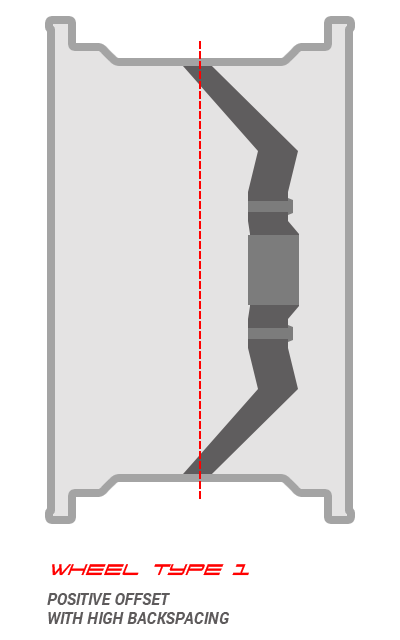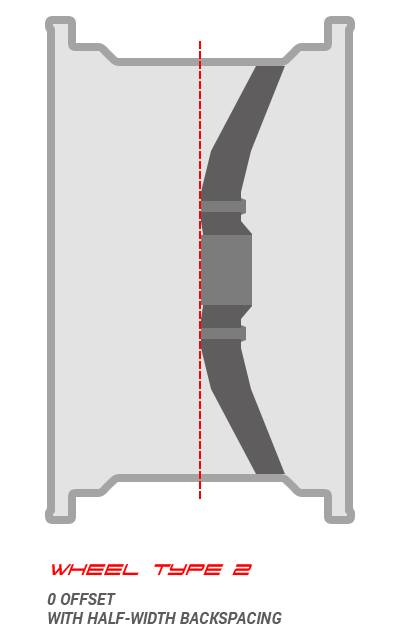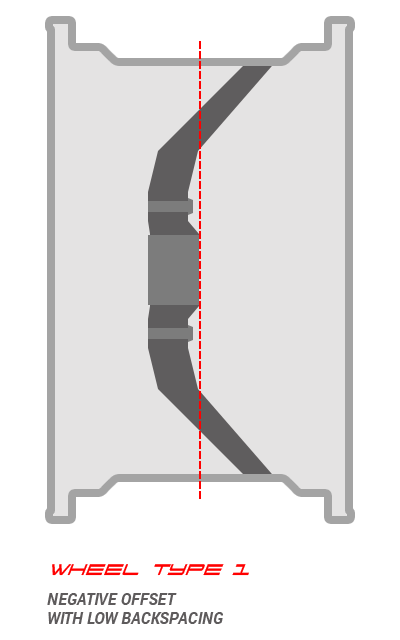When going widebody, changing the wheels and suspension is a must if you’re looking into building a complete-looking “project car”. Using spacers isn’t a crime (unless you’re not using 80mm’s per side – these look awful and honestly should be treated as a very temporary solution), yet it’s often best to get a lower-offsetted, concaved wheel that will nicely outline the widebody sithoulette.
Frequently asked: wheel types and offsets (ET)
[vc_message]In this article, we cover different wheel types that some of you might not be familiar with. Building up a wide-bodied car should be followed by a wider wheel to alter and complete the car’s looks.[/vc_message]
High backspacing,
positive offset wheel
Wheels with high backspacing and positive ET may be considered as the regular, popular rims that you can meet in most of the cars. Wheels with high offset (ET) value can also be seen in various sportscars with lots of power due to bigger clearance (if we presume that the wheel design is done with that in mind) when it comes to big-brake calipers.

Half-width backspacing,
0 offset wheel
Wheels with half-width backspacing and ET0 are mostly seen in cars that have been modified (they went widebody). ET0 gives them plenty of poke and the ability to get a nice concaved look when combined with a wide rim. One of the best examples is our modified Mercedes-Benz (20×10+20×12 ET0 in MB SL).

Low backspacing,
negative offset wheel
Negative-offsetted wheels are the ultimate weapon in many cars that went widebody with some +3′ flares. Best looking when done as a deep-concaved 2 or 3-pieced wheel. A great example of a deep-concaved, negative-offsetted wheel can be seen on some of the Audi A5’s in our Gallery (in most cases they got 20×11 ET-15).
1-piece wheels (monoblocks)
1-piece wheels aka monoblocks are the most popular wheels out there. Nearly all cars leave the factories on that type of wheels these days. Thanks to the manufacturing processes, which are less time-consuming, they also tend to be the cheapest wheel types on the market.
Monoblocks can be found in various wheel sizes and offsets, yet due to the production limitations, it’s quite hard to find more exotic wheel specs (for example an ET0 wheel in widths of about 11-12inches). Monoblocks are made as cast wheels, hybrid-forged wheels, flow-formed wheels, and forged wheels. The last ones, when made per order have the ability to go with some extreme dimensions and offsets, yet their cost of production/purchase is also high.
2-piece, 3-piece wheels (aka 2TLG, 3TLG)
3-piece wheels are the most common, yet the most expensive tuning wheels on the market. Usually, they are done as a forged set. A 3-piece wheel consists of the wheel barrel, wheel lip, and a rotor. A 2-piece wheel consists of the wheel barrel and a rotor (lip is already part of the barrel).
All of the pieces are tightened by screws. Thanks to the wheel’s modular build, one has the ability to update only part of the wheel when going widebody, without the need of changing the whole wheel.